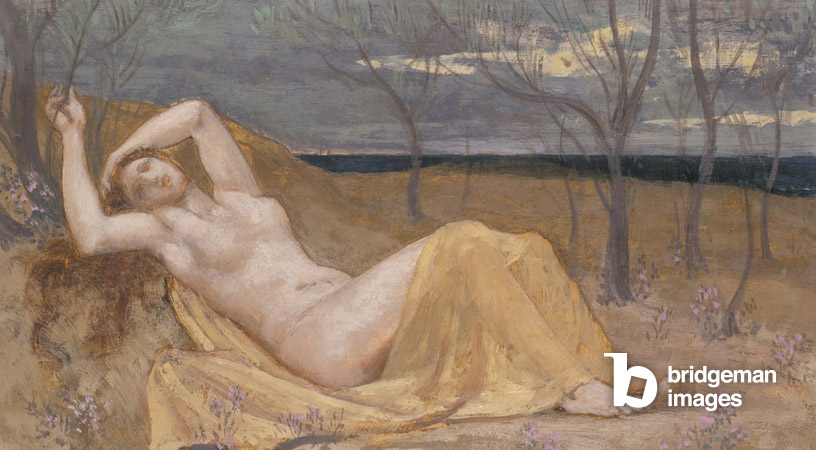Published 13/07/2023
Symbolism, was born in the late 19th century as a reaction against rationalist and materialist ideals. The artistic movement extended from literature to the fine arts. Favouring the subjective expression of emotions and ideas, it offered artists an unprecedented creative freedom.
View our selection of Symbolist works
Symbolism was born as a French literary movement in the 1880s, gaining popularity with the publication of Jean Moréas' manifesto in Le Figaro in 1886. It emerged as a reaction to the prevailing rationalism and materialism in Western European culture, advocating for the validity of pure subjectivity and the expression of an idea rather than a realistic description of the natural world.
This philosophy, influenced by poet Stéphane Mallarmé's belief that reality was best expressed through poetry as it parallels nature rather than reproducing it, became a fundamental principle of the movement.
Stated by Mallarmé:
"To name an object is to suppress three-quarters of the enjoyment derived from the poem... suggestion is the dream."
(Original French quote: "Nommer un objet, c'est supprimer les trois quarts du plaisir qu'on trouve dans le poème... la suggestion, voilà le rêve.")
Symbolism in the Visual Arts
Although it was initially rooted in literature, Symbolism quickly became associated with a younger generation of painters who sought to reject the conventions of Naturalism. Symbolist painters believed that art should reflect an emotion or an idea rather than objectively and quasi-scientifically representing the natural world, as Realism and Impressionism did. By reconnecting with the personal expressiveness advocated by the Romantics of the 19th century, they considered the symbolic value or meaning of a work of art to arise from recreating emotional experiences in the viewer through colour, line, and composition. In painting, Symbolism represented a fusion of form and feeling, of reality and the artist's inner subjectivity.
The Precursors of Symbolism: Dreamlike Worlds and Enigmatic Figures
In an article on Paul Gauguin published in 1891, Albert Aurier provided the first definition of symbolism as an aesthetic, describing it as "the subjective vision of an artist expressed through a simplified and non-naturalistic style," and hailing Gauguin as its leader. However, the foundations of pictorial Symbolism were laid as early as the 1870s by an older generation of artists such as Gustave Moreau, Puvis de Chavannes, Odilon Redon, Eugène Carrière, Arnold Böcklin, and Edward Burne-Jones.

Symbolist artists sought to imbue their works with spiritual value, creating imaginary worlds populated by mysterious figures drawn from biblical narratives, Greek mythology, and fantastical creatures.
Their evocative imagery established the most prominent themes in Symbolist art: love, fear, anguish, death, sexual awakening, and unrequited desire. Women became the favoured symbol for expressing these universal emotions, appearing alternately as melancholic virgins and menacing femme fatales.
Diversity in Artistic Symbolism: A Rebellion against the Decay of Modern Society
Unlike the Impressionists, the emerging Symbolists of the 1880s were a diverse group of artists often working independently, with varied aesthetic goals. Instead of sharing a single artistic style, they were united by a shared pessimism and weariness towards the perceived decay of modern society. Symbolists sought to escape from reality, expressing their dreams and personal visions through color, form, and composition.

Their nearly universal preference for broad brushstrokes and flat, often abstract forms was inspired by Puvis de Chavannes, who created simplified shapes in order to clearly express abstract ideas. His subdued color palette and decorative treatment of forms had a significant influence on a new generation of artists, including Gauguin and the young Pablo Picasso.
Gauguin and His Vision of Symbolism: A Quest for a Lost Paradise
Gauguin's Symbolism was unique in that he sought to escape civilization by turning to so-called primitive and less industrialized cultures, rather than the imaginary dreamlike world favored by his predecessors. His painting "Vision of the Sermon" marked his first intentionally Symbolist work.

Gauguin's quest for a lost paradise ultimately led him to the South Seas, where he filled his canvases, prints, and sculptures with highly personal and esoteric imagery that deliberately eludes clear interpretation.
An Internationalisation of the Rejection of Naturalism and Narrative
Although Symbolism originated in France, it quickly became an international avant-garde movement that expanded across Europe and North America during the last two decades of the 19th century. The Norwegian artist Edvard Munch, closely associated with Symbolist circles, spent time in Paris before settling in Germany in the early 1890s. Munch's intensely personal style, often referred to as Symbolic Naturalism, depicted subjects rooted in the anxieties of modern existence rather than exotic or fantastical themes.

Almost all of the paintings he produced between 1893 and 1902 are part of a series called "The Frieze of Life." These paintings explore themes of illness, loneliness, despair, and mental suffering associated with love, conditions that Munch considered emblematic of "modern psychic life."
In Central Europe, Symbolism experienced a late revival through the Vienna Secession, particularly in the works of Gustav Klimt, who expressed a deep fascination with the productive and destructive forces of female sexuality. Klimt's highly ornamental style reveals the close connection between Symbolism and parallel movements in decorative arts such as Art Nouveau.
.jpg)
The rejection of naturalism and narrative in favor of the subjective representation of an idea or emotion by the Symbolists had a significant influence on 20th-century art, particularly on German Expressionism and abstraction.
View our selection of Symbolist works
Please feel free to reach out to our team; we are always happy to assist you in your research, with no obligation or additional cost.


